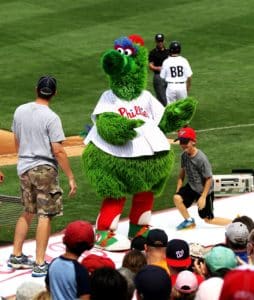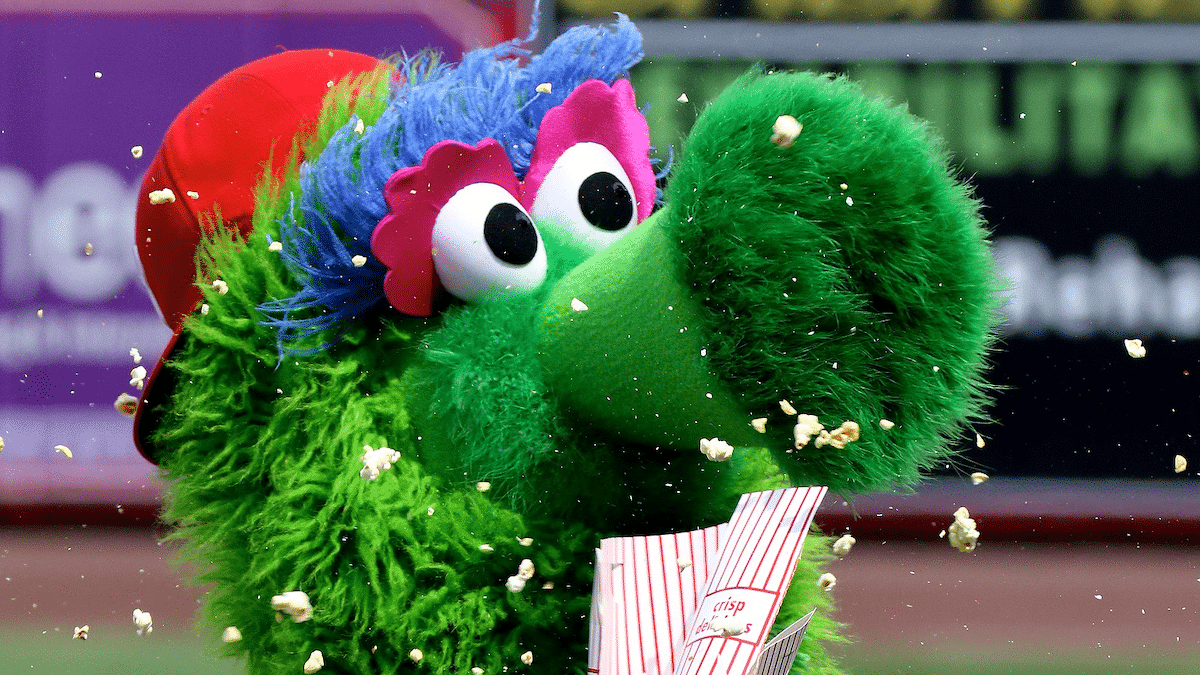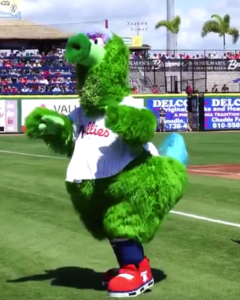The Battle Over the Phillie Phanatic
#respecttheconicalhonker
Last week, at their first spring training game in 2020, the Philadelphia Phillies introduced a new version of their iconic mascot, the Phillie Phanatic. The new mascot looked largely the same but had a number of distinctions including a slimmer look, new stars around its eyes, cylindrical cone for a honker, a blue tail and dragon scales.
The changes did not go over particularly well with the fans with many taking to social media to protest the changes with the hashtag #NotMyPhanatic and John Oliver, as part of his weekly news/comedy show, doing a 6-minute segment highlighting the backlash.
However, what’s riling the fans isn’t just the changes but the reasons for those changes. Though the Phillies have not said as such directly, it is widely believed that the tweaks to the iconic character are an attempt to circumvent an ongoing copyright challenge that pits the costume’s original creators against the team.
That’s because, under all of the green fur and silly antics, lies some very serious and complicated copyright issues that go well beyond the fate of this one mascot. As such, it’s important to take a step back, look at this history of this case and the exact legal issues at play.
A Brief History of the Phanatic

When the Phillie Phanatic made his first appearance on April 25, 1978, he had actually been months in the making. The team contracted with Bonnie Erickson and Wayde Harrison, the former of which had worked with Jim Henson and was responsible for various famous Muppets.
The duo was paid $3,900 for the creation of the original mascot costume. However, at the time, the Phillies opted to save $1,300 and not purchase the copyright to the character. A decision that the team’s then-vice president Bill Giles referred to as “the worst decision” of his career.
Six years later, in 1984, the team reconnected with Erickson and Harrison about buying the copyright. However, by then the character had grown wildly in popularity and, instead of paying $1,300, they paid some $250,000 for the rights.
Since then, the Phanatic has gone on to be one of the most popular and recognizable mascots in the country. Famous for both his appearance and his antics, the mascot is much-beloved but still very heavily identified with the city of Philadelphia.
That makes what happened in 2018 sting for a lot of people. That was when Erickson and Harrison filed a notice of termination, indicating that they plan on terminating the 1984 agreement effective in 2020.
The Phillies responded in August 2019 by filing a lawsuit against the duo. There, they are seeking a declaratory judgment that the Phanatic is not eligible for copyright termination and that they should not be able to sue for copyright infringement.
To that end, they offer up a variety of legal theories including renegotiations over the years have ended the ability to terminate, that the copyright registration in the costume was erroneous and that the Phillies are actually co-authors both in the costume and the character at large.
They further claim that threats to make the Phannatic a “free agent” are a violation of trademark law.
The case is ongoing but, in the midst of it, the Phillies introduced their “new” Phanatic, which many believe was an attempt to circumvent the claims by Erickson and Harrison. That, in turn, brings us to the disastrous fan response last week and to the current situation we’re in.
However, to figure out what is likely next, we have to take a look at copyright termination, what it is and how it likely applies in this case.
The Basics of Copyright Termination
We discussed copyright termination in more detail back in 2011, however, the basics are actually fairly straightforward.
Copyright termination was first codified into law with the Copyright Act of 1976, which took effect on January 1, 1978. Copyright Termination makes it so that original creators of an original work or their heirs can terminate any copyright transfer or exclusive license arrangement after a set period of years.
For works where the assignment took place before 1978, the term is 56 years after the assignment. For works where the assignment took place during or after 1978, that term 35 years.
The aim of this law was to allow creators a “second bite at the apple” when it comes to negotiating their licenses. When a work is new and its value is unknown, many creators sell their copyrights for an extremely small amount (see the $1,300 original offering for the Phanatic).
This means that original creators often see very little revenue from very lucrative works and copyright termination aimed to give them a chance to renegotiate their deals or to simply reclaim the rights to their work so they can exploit it directly.
It’s worth noting that copyright termination does NOT apply to works made for hire. However, for other works, copyright termination is not a right that can be waived, it is considered to be inalienable.
All of that brings us to the Phillie Phanatic. If the costume was not a work made for hire, the right itself is inalienable (meaning the Phillies’ claim of a “forever” are off-target) and the required 35 years have passed, what is the complexity?
A lot. Actually. A lot.
The Complexities with the Phillie Phanatic
The Phanatic is far from a straightforward copyright termination case (not that any of them are). The reason is that the mascot not only intersects with other areas of copyright law, but also trademark law.
The first problem is the question of who exactly owns what. Though there’s no doubt that Erickson and Harrison were contracted to create the costume, the Phillies claim that they made several crucial decisions in its design, making them effectively co-authors.
But, even if that isn’t the case, it’s pretty clear that the character of the Phanatic goes well beyond just the costume. His personality, mannerisms and general character were created the Phillies and their employees.
Even if Erickson and Harrison are able to reclaim the rights to the original costume, it doesn’t mean that they own the whole of the character. As we saw with Sherlock Holmes and with Superman, characters can be divided between creators and even between what is in or out of the public domain.
The trademark issues are also thorny as Erickson and Harrison have no claim to the name The Phillie Phanatic. While they could, at least in theory, reclaim the copyright in the costume they created, they wouldn’t be able to use the name or elements of the character not created by them anywhere else they took it.
To be clear, these are just some of the legal complexities at play. How more recent renegotiations impact termination and the questions over the registration will also need to be addressed by the courts.
But none of this is to say that the Phillies are totally in the right either. The new Phanatic, which the original creators called an “affront” to their creation, doesn’t actually change much. It would very likely be seen as a derivative work of the original costume as, despite the changes, it is pretty clearly based on the original Phanatic design.
The truth is that the new Phanatic really doesn’t change much in this case other than possibly as a negotiating tactic. Still, when one considers that litigation is often about negotiation, it might still be a very impactful move down the road. Only time will tell.
Bottom Line
In the end, what seemingly should be a very simple case is actually a big, complicated mess that intersects multiple areas of not just copyright law, but trademark law, contract law and more. There is nothing easy about this case.
However, even if Erickson and Harrison do eventually win the right to terminate the transfer, that doesn’t mean that the Phanatic, as we know him, will automatically become a free agent. The costume may, but his name and other aspects of his character likely won’t.
The most likely (and most obvious) outcome of this case is a settlement. Though the case will likely move farther along first, it’s a situation where it’s in everyone’s best interest to work this out.
It may not be a quick settlement and will likely come after the courts begin to address more of the claims and counterclaims, but it’s in no one’s best interest for the Phanatic to leave Philadelphia.
No matter how the case is resolved, I have little doubt that the resolution can’t come soon enough for fans of the Phillies of the Phanatic.
Want to Reuse or Republish this Content?
If you want to feature this article in your site, classroom or elsewhere, just let us know! We usually grant permission within 24 hours.

